Introduction
Liverpool has alway had a fascination for me which I mentioned in a 2009 post Liverpool and subsequent posts about the railways. In the post By rail to Liverpool (Part 1), I described my journey on Saturday, 8th March 2014 via the former Great Western and former Great Central lines to Bidston station, on the Wirral. This post describes my travels from Bidston that day.
By Merseyrail from Bidston
Despite the roar of traffic from the nearby elevated M53 motorway, Bidston manages to give a very rural impression, surrounded by greenery, a lot of it no doubt where nature has taken back the land after the extensive goods sidings were removed. From earlier visits, I remember Bidston Dee Jn. signal box, a 65-lever L.M.S. construction facing the platform. That's now gone - most of the Merseyrail network is now controlled from Sandhills Control Centre. By the time I'd purchased my Merseyrail ticket, a train from West Kirby was arriving, headed for Liverpool Central and, although it was already crowded, I decided to board. This meant deferring a trip to West Kirby until another visit. Shortly after the train left Bidston, the line from New Brighton converged on our left and I was now retracing the route I'd last used on my trip on 8th February 2014 (described here). When we stopped at Birkenhead North, I was amazed to find major progress on the new footbridge incorporating lifts for disabled access.
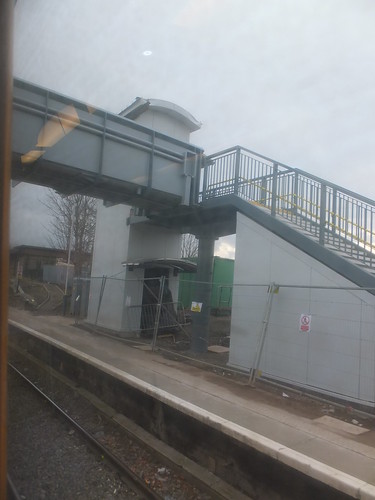
The new footbridge under construction at Birkenhead North.
I had toyed with the idea of getting off at Birkenhead Park. This was originally the end-on junction between the Mersey Railway and the Wirral Railway and provided with four platforms. Until the L.M.S. electrified the Wirall Railway lines, through passengers had to change between electric and steam trains and it must have been a busy place. Now, it's reduced to a single island platform between Up and Down lines, with steps leading up to station buildings on the road overbridge. The road is Duke Street, which, further north, divides the West Float and East Float as I described in my earlier post. Anxious to make the most of my limited time, I abandoned the idea of getting off and stayed on the even more crowded train as it called at Conway Park and Hamilton Square.
After Hamilton Square, we passed under the River Mersey using the first tunnel built under the Mersey. There's a little more about the tunnel-building in my post here. I still find it hard to believe that from 1886 to 1903, the trains through the tunnel were worked by steam traction.
Liverpool
The first station on the Liverpool side of the river is James Street and, originally, the line continued to an underground terminus at Liverpool Central, as shown in my post here. In 1977, British Railways opened the underground 'Liverpool Loop' and now, after James Street, trains call at Moorfields, Lime Street and Central, before re-appearing at James Street heading in the opposite direction.
I left the train at Central and escalators took me to the surface. It's a modern station but I found it quite pleasant, even at lunchtime on a Saturday when it appears that everyone wants to travel. A particularly civilised detail was the clean, free toilets so I emerged into the streets in a fairly relaxed mood.
A Walk through Liverpool
I'd initially intended to continue my journey by train but the streets were busy with apparently good-natured pedestrians and the weather was dry for a while, so I decided to stay 'topside'. Feeling peckish, I bought takeaway fish cake and chips at a small, scrupulously clean cafe and sat at a nearby junction where there were lots of seats and litter bins and enjoyed my food while I watched the shoppers go by.
I admired what I afterwards discovered was only the modest side elevation of the Lyceum. The neo-classical Lyceum was designed by the architect Thomas Harrison from Chester following an open competition with the local Liverpool architect John Foster (Surveyor to the Corporation of Liverpool). The Lyceum was built between 1800 and 1802 and has a colonnaded front facing Bold Street which I didn't study on this trip. The building has served various functions over the years (including Post Office) but is largely unused at present and the owner's of the Grade II Listed Building are seeking a new tenant or a sale. The Waterloo Place facade which caught my attention has four Ionic columns with three relief panels by F.A. Lege. Once, this facade housed the entrance to the Library and Newsroom, now it's the Co-operative Bank (or 'The co-oper.tive b.nk' as the sign declared. Perhaps there's a ready market for stolen letter 'a'?).
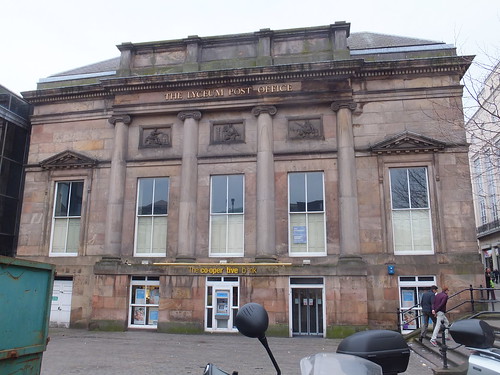 The Waterloo Place facade of the Lyceum.
The Waterloo Place facade of the Lyceum.
Having finished my meal, I decided to walk through the city to Pierhead, with the idea of using the Mersey Ferry to cross back to the Birkenhead side. My route took me through the pedestrianised Church Street, then Lord Street and Derby Square (where there's an elaborate memorial to Queen Victoria).
 Victoria Memorial, Derby Square.
Victoria Memorial, Derby Square.
I continued down James Street, passing the Merseyrail Station on the right, with its bus stop outside for easy interchange. I approve of the attempt at an integrated transport system, but the ugliness of the associated street furniture and station facade contrasts sharply with the pleasing appearance of the Mersey Tunnel Pumping Station, framed against a background of acres of unrelieved black glass of the Mann Island modern development.
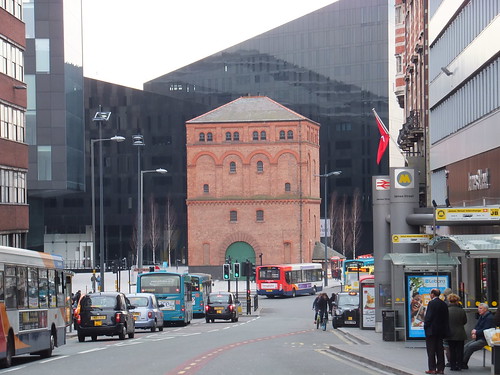 Looking down James Street, the black glass of the modern developments highlights the clean lines of the Mersey Railway Pumping Station, still at work.
Looking down James Street, the black glass of the modern developments highlights the clean lines of the Mersey Railway Pumping Station, still at work.
Then I crossed the wide dual-carriageway of Strand Street and passed the ventilating shaft and associated offices of the Mersey Road Tunnel. The architectural style is not my favourite but the sense of proportion lends a satisfying dignity quite missing from much modern work (like the black glass Mann Island development mentioned above).

Mersey Road tunnel ventilating shaft and offices.
The Museum of Liverpool
There remained time to make a very brief visit to The Museum of Liverpool (part of Liverpool Museums) just to check on the centre piece of the 'Great Port' Gallery - the locomotive 'Lion'.
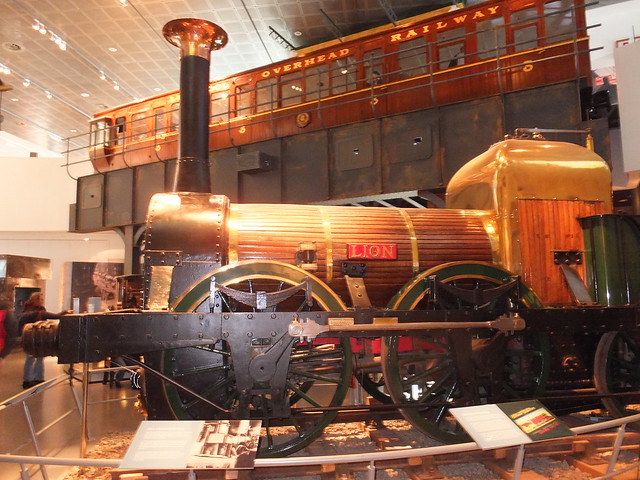 'Lion' on display in the Great Port Gallery, with the Liverpool Overhead Railway coach in the background.
'Lion' on display in the Great Port Gallery, with the Liverpool Overhead Railway coach in the background.
I'm still secretary of the Old Locomotive Committee (the 'Lion' supporters club) and I've written a number of posts which are here. But I don't think I'll ever grow to love the 21st century architecture of this museum on a World Heritage Site designed by the Danish architects 3XN. Originally 'Nielsen, Nielsen and Nielsen', they became '3 x Nielsen' and then '3XN'.
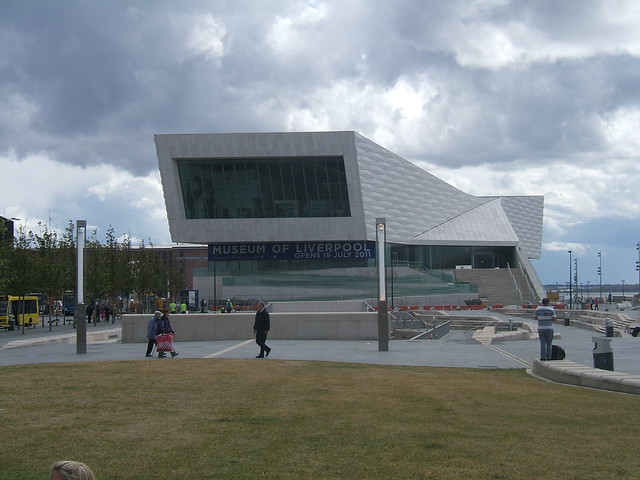 The Museum of Liverpool shortly before opening to the public in 2011 - "Fourth Grace" or "Dented Shoebox"?
The Museum of Liverpool shortly before opening to the public in 2011 - "Fourth Grace" or "Dented Shoebox"?
Ferry Cross the Mersey
Then on to Georges Pierhead and the Booking Office for the Mersey Ferry. This is another modern building suffering the same affliction as the Museum of Liverpool and the Mann Island Developments - a morbid fear of the Right Angle. But the Staff were friendly and, clutching my Boarding Pass, I was soon making my way outside to await the arrival of the Mersey Ferry 'SNOWDROP'.
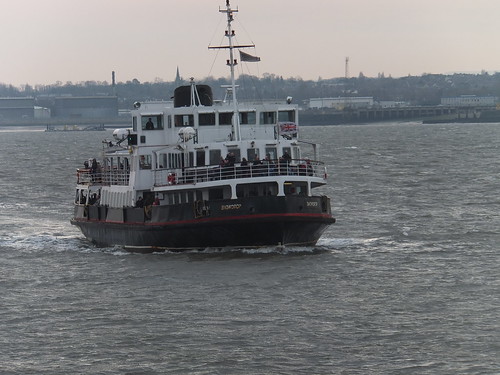 Mersey Ferry 'Snowdrop' approaching Pierhead.
Mersey Ferry 'Snowdrop' approaching Pierhead.
The ferry leaves Pierhead 'on the hour', calling first at Seacombe and then Woodside before returning to Pierhead for the next trip. With a well-loaded ferry, we were under way right time.
This time, there was no Cruise Ship at the adjacent terminal but, instead, the rather threatening bulk of HMS Dragon - a Type 45 'Daring' class Air Defence Destroyer. You can learn more on Wikipedia here or the Royal Navy site here.
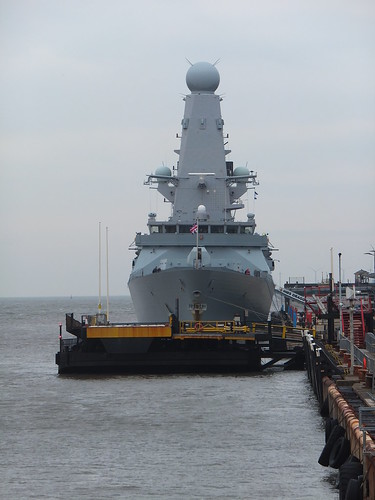
HMS Dragon is a Type 45 'Daring' class Air Defence Destroyer, seen making a weekend visit to Liverpool.
The sun was bright but there was a strong wind. Within a few minutes, the ferry was berthing at Seacombe. The Captain and First Officer were relieved by two more men, presumably just starting an afternoon 'watch'. There was a little pantomime when the gangway was raised before it was realised that the relieved men were still aboard, so the gangway had to be lowered again to let them disembark.
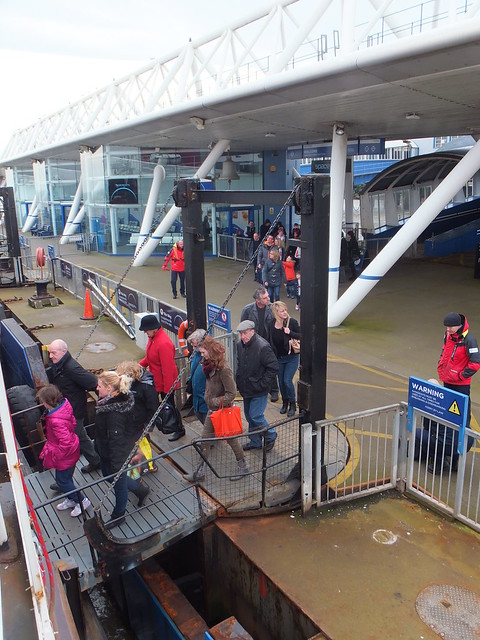
Passengers boarding at Seacombe Landing Stage.
The ferry then continued upstream to Woodside Landing Stage, passing the lock gates giving access to Birkenhead Great Float and Stena Line's 12 Quays Terminal where the Isle of Man ferry 'Ben-My-Chree' was berthed. This ferry is described in Wikipedia here.
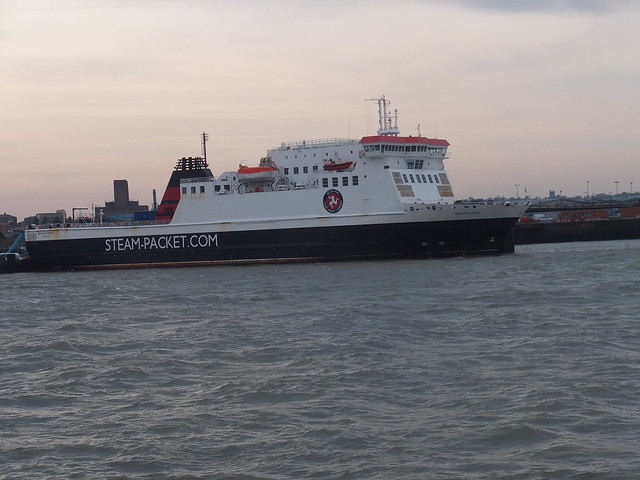 Isle of Man ferry 'Ben-My-Chree'.
Isle of Man ferry 'Ben-My-Chree'.
Birkenhead Briefly
I disembarked at Woodside and walked to Hamilton Square Station, passing the Mersey Railway Pumping Station at Shore Road. This is similar in appearance to the one on the Liverpool side (mentioned above) but larger. Although electric pumps now do the work, the original steam pump, 'The Giant Grasshopper' is still in situ. A few years ago, I was able to visit and see the pump operating (using air, not steam) but I believe it's closed at present because of financial constraints.
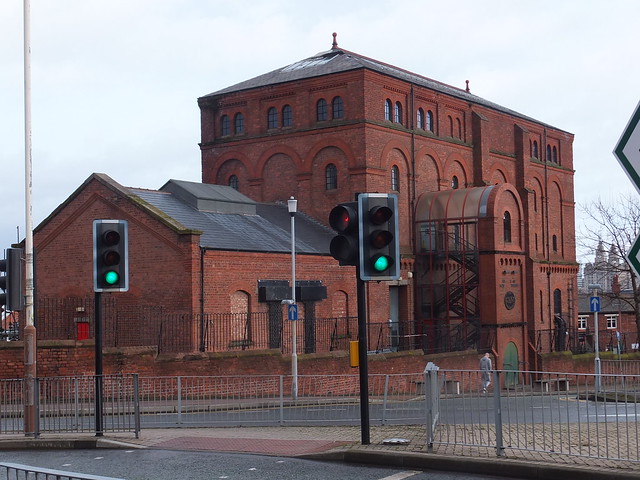 Birkenhead: Pumphouse with 'The Giant Grasshopper' pump.
Birkenhead: Pumphouse with 'The Giant Grasshopper' pump.
Entering Hamilton Square Station, I took the lift to Platform Level and caught the first train towards Chester, on the route I'd travelled on 8th February 2014, described in the post here.
I decided to alight at Bebington station and pay a visit to the Lady Lever Art Gallery at Port Sunlight. Bebington was formerly on a four-track route paired by use, with one island platform flanked by single platforms either side. A subway provided access to the platforms. Merseyrail now uses only the old slow lines, so the subway ramp I took leaving the station originally served the island platform.
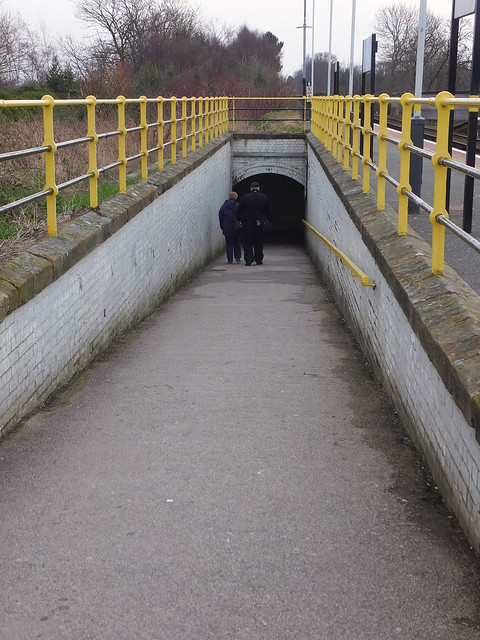
Mersey rail: Access ramp at Bebington Station.
Lady Lever Art Gallery
In the post Birkenhead and New Brighton by train (Part 1) I wrote a little about Port Sunlight. I'm afraid I found the Model Village rather 'twee', although I admire William Lever's intentions. In a real village, a clash of building styles over time can be attractive but when each block deliberately differs from its neighbour in a self-conscious manner, as here, I'm not so sure.
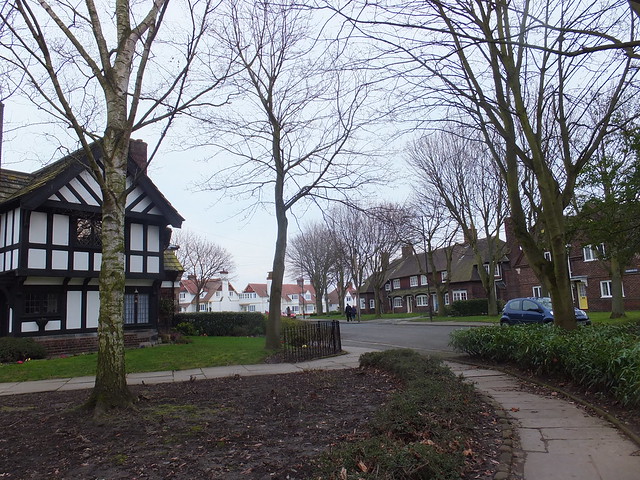 Port Sunlight, showing varying building styles.
Port Sunlight, showing varying building styles.
A ten-minute walk from the station took me to the Lady Lever Art Gallery. The Gallery was opened in 1922 by William Lever (by then the First Viscount Leverhulme) and named in memory of his wife Elizabeth. It was designed by architects William and Segar Owen from Warrington and is now Listed Grade II.
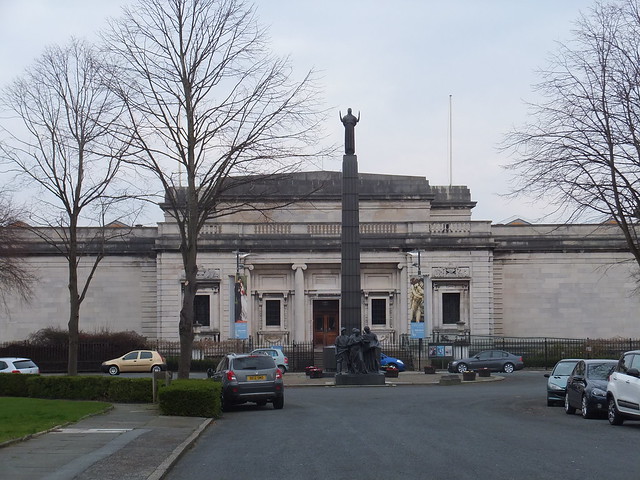 The Main entrance to the Lady Lever Art Gallery.
The Main entrance to the Lady Lever Art Gallery.
The Collection was always intended for public display, not as a rich man's private pleasure. Lady Lever Art Gallery claims it "houses one of the UK’s finest collections of fine and decorative art. It has the best collection of Wedgewood jasperware anywhere in the world and its collection of Pre-Raphaelite paintings is internationally renowned". Display is fairly traditional and certainly worked for me. I was enchanted by the place.
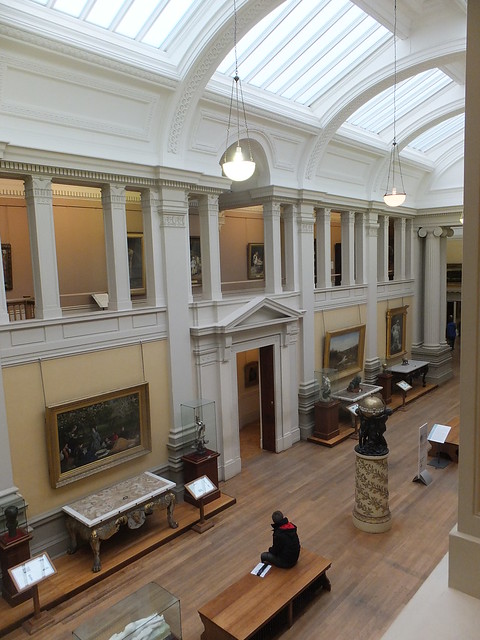
View of the Main Hall from the East Balcony Gallery.
The Art Gallery is now part of Liverpool Museums and the contrast with the Museum of Liverpool I'd visited earlier could hardly be more pronounced.
The Lady Lever Art Gallery has a special exhibition of the works of J.M.W. Turner until 1st June 2014. I was able to study around 30 works from different periods of his life during my visit.
The Journey Home
I walked back to Bebington Station to catch the next train south. This was an Ellesmere Port train and, at first, I intended to travel to Ellesmere Port. However, during the journey, I decided that I'd had enough adventures for one day so I 'bailed out' at Hooton and transferred to the following Chester train.
At Chester, my onward connection was from the platform 2 bay. We took the North Wales Coast route to Saltney Junction where we turned left onto the (now singled) former Great Western line to Wrexham. At Wrexham General, we were back on double track and I rejoined the route out I'd taken that morning.
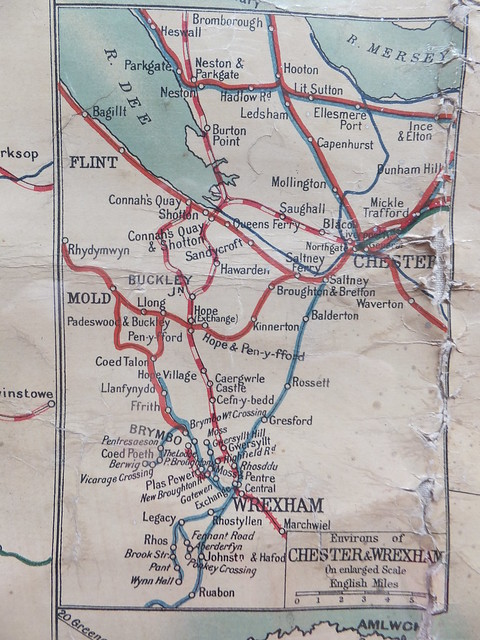 'Environs of Chester & Wrexham' from the 11th Edition of the Pre-Grouping 'Railway Map of England and Wales' published by W & A K Johnston.
'Environs of Chester & Wrexham' from the 11th Edition of the Pre-Grouping 'Railway Map of England and Wales' published by W & A K Johnston.
The train from Chester took me as far as Shrewsbury where I alighted on platform 4. The train then continued - for Cardiff, I think, but I was quite tired by this time and not paying attention. The next arrival on platform 4 was my connection, arriving from Aberystwyth (I think) and reversing before going on to Birmingham International, allowing me to get off at Wolverhampton.
Another excellent (if exhausting) day trip.
Book references
[1] 'An Illustrated History of Liverpool's Railways' by Paul Anderson, published Irwell Press (ISBN 1-871608-68-6).
[2] 'A Regional History of the Railways of Great Britain': Volume 10 The North West by G. O. Holt, Second Edition published by David & Charles (ISBN 0946537 34 8).
Related posts on this site
By rail to Liverpool (Part 1)
Early Days of the Mersey Railway.
Birkenhead and New Brighton by train (Part 1)
Birkenhead and New Brighton by train (Part 2)
Birkenhead and New Brighton by train (Part 3)
Railways around Birkenhead
My pictures
Merseyrail.
Liverpool.
Museum of Liverpool.
Port Sunlight, Wirral.
